Saturday, 24 September, Golubac, Serbia (Lepenski Vir and Golubac Fortress)
Written 8 October 2022
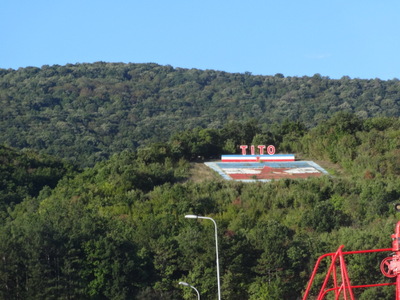
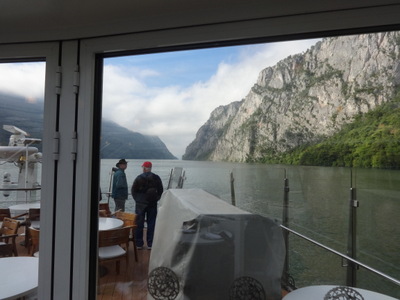 We set our clocks back an hour last night, so now (and for the rest of the trip) we're on ordinary western European time (1 hour later than Greenwich). At our entrance into the former Jugoslavia, we were greated by this huge monument to Tito, it first and only ruler, and shortly thereafter we approached and passed through the famous "Iron Gate" on the Danube. The Danube has been dammed at this point, so we had to climb over the dams—we passed through the lock at the first dam during the night, but about 6:30 am, I got to watch our passage through the second, which was a double. The first chamber opened directly into the second. This lock's doors open like scissors; the top have goes up and the bottom half goes down. We seemed to be the only vessel in this lock.
We set our clocks back an hour last night, so now (and for the rest of the trip) we're on ordinary western European time (1 hour later than Greenwich). At our entrance into the former Jugoslavia, we were greated by this huge monument to Tito, it first and only ruler, and shortly thereafter we approached and passed through the famous "Iron Gate" on the Danube. The Danube has been dammed at this point, so we had to climb over the dams—we passed through the lock at the first dam during the night, but about 6:30 am, I got to watch our passage through the second, which was a double. The first chamber opened directly into the second. This lock's doors open like scissors; the top have goes up and the bottom half goes down. We seemed to be the only vessel in this lock.
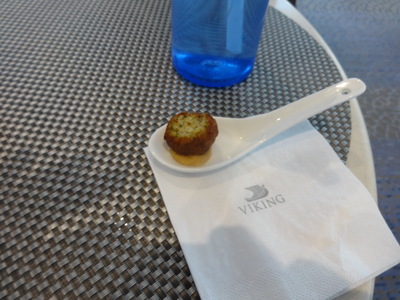
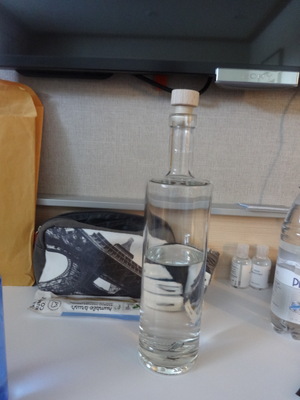 Hors d'oeuvres were passed at 11 am in the lounge. I got a lttle ball of falafel on hummus. At the right is a photo of the water bottle in my stateroom. Viking keeps us well supplied with water. You find one of these quart glass bottles, with synthetic cork and shrink-wrap seal, in your room when you arrive, and they replace them as fast as you can use them up. If you leave one half full, they add a new one.
Hors d'oeuvres were passed at 11 am in the lounge. I got a lttle ball of falafel on hummus. At the right is a photo of the water bottle in my stateroom. Viking keeps us well supplied with water. You find one of these quart glass bottles, with synthetic cork and shrink-wrap seal, in your room when you arrive, and they replace them as fast as you can use them up. If you leave one half full, they add a new one.
About lunch time, I spotted little yellow Nymphaea-shaped water lilies floating downstream, together with their lily pads as though torn loose somewhere above.
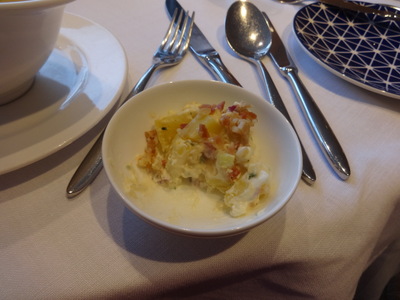
 The fine-print starter was a little dish of potato salad with bacon.
The fine-print starter was a little dish of potato salad with bacon.
The official starter was celery-root soup with sweet garlic chips and bits of celery stalk. Excellent.
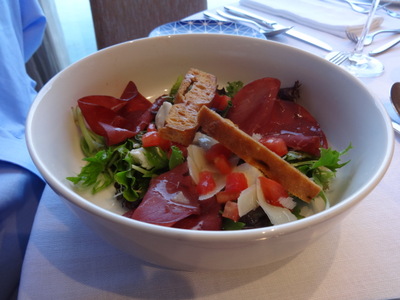
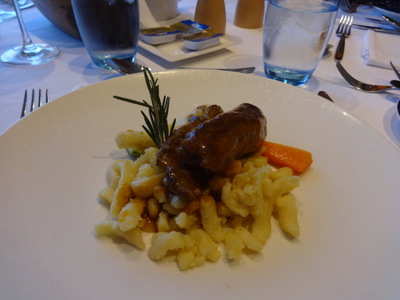 David started with the "Italian salad." The red slices are bresaola, air-dried beef.
David started with the "Italian salad." The red slices are bresaola, air-dried beef.
My main course was this "beef roll," a slice of beef wrapped around a pickle spear and braised to fork tenderness, served with its gravy on a mound of spätle. Carrot on the side. Very good!

 David's main course was pasta Alfredo. Then I think we both had the banana cake—a layer of banana slices sandwiched between two layers of cake and topped with a little chocolate.
David's main course was pasta Alfredo. Then I think we both had the banana cake—a layer of banana slices sandwiched between two layers of cake and topped with a little chocolate.
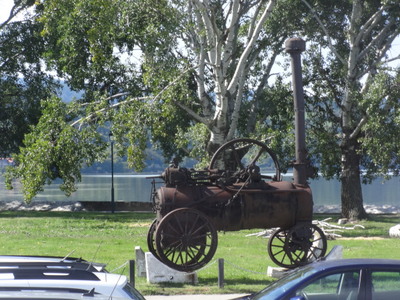
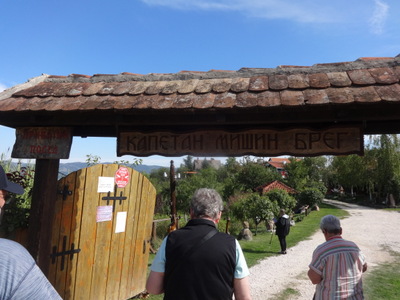 This antique (a fire engine? farm equipment?) was on display where the ship moored briefly after lunch (Donji Milanovac, billed as is the smallest town in eastern Serbia; only 2000 people) to let us off for our afternoon excursion. We had to take our passports with us, because foreigners are required to carry them everywhere they go in Serbia, so we checked them out from the Viking vault for the duration of our time in the country.
This antique (a fire engine? farm equipment?) was on display where the ship moored briefly after lunch (Donji Milanovac, billed as is the smallest town in eastern Serbia; only 2000 people) to let us off for our afternoon excursion. We had to take our passports with us, because foreigners are required to carry them everywhere they go in Serbia, so we checked them out from the Viking vault for the duration of our time in the country.
As our bus passed through the town, our guide pointed out monument to the Balkan wars and WWI. Lots of flowers in the town. The elementary school is dedicated to the linguist who regularized the Serbian language, which is spelled strictly phonetically. The church is St. Nicholas; apparently all Serbian churches near the river are dedicated to him as the patron saint of fishermen and river people. The Hotel Lepinski Vir is on top of a hill and is the biggest hotel in eastern Serbia. The town also includes the oldest houses in eastern Serbia. One out of the town and on our way up the mountain, we passed little wooden dachas, summer vacation homes, as well as giant tractor tires being used as part of the retaining walls protecting the the road.
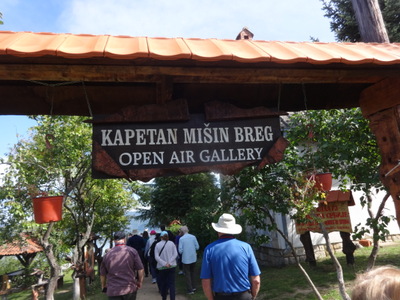
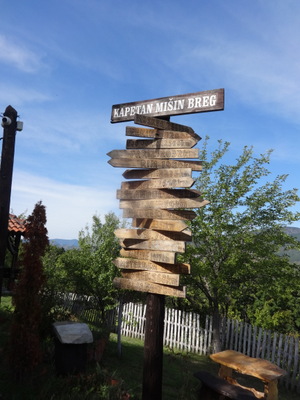 We were signed up for the 1:30 pm trip to the archeological site of Lepenski Vir, but after 10 or 12 minutes on the bus, we stopped at the Kapetan Mišin Breg Open Air Gallery for a snack and sight-seeing. That's its front gate in the right-hand photo. Kapetan Mišin is apparently something of a local hero. He made his money in trade and became a philanthropist. He left two of his houses to the local people—one became a university and the other the National Bank of Romania.
We were signed up for the 1:30 pm trip to the archeological site of Lepenski Vir, but after 10 or 12 minutes on the bus, we stopped at the Kapetan Mišin Breg Open Air Gallery for a snack and sight-seeing. That's its front gate in the right-hand photo. Kapetan Mišin is apparently something of a local hero. He made his money in trade and became a philanthropist. He left two of his houses to the local people—one became a university and the other the National Bank of Romania.
Here's the gate from the other side, where we could actually read the sign.
The owner and artist is something of an excentric. He always goes barefoot, saying he takes positive energy from the ground. He has assembled this set of signposts displaying distances to just about everywhere in the world.
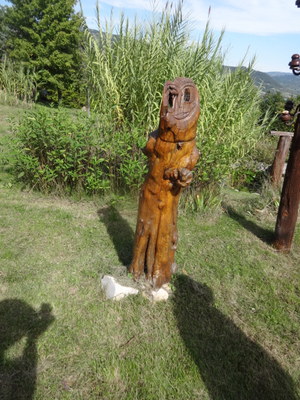
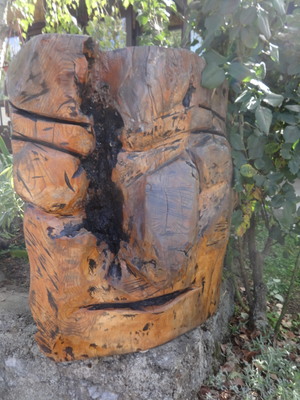 His avocation is to search the woods for pieces of wood in which he sees shapes. He then further shapes them to bring out what he sees, varnishes them, and displays them throughout the grounds, which include fruit orchards, paths, flower beds, and lawns, as the "Wood and Water" gallery. They are not for sale.
His avocation is to search the woods for pieces of wood in which he sees shapes. He then further shapes them to bring out what he sees, varnishes them, and displays them throughout the grounds, which include fruit orchards, paths, flower beds, and lawns, as the "Wood and Water" gallery. They are not for sale.
Some of the shapes he sees are more recognizable than others.
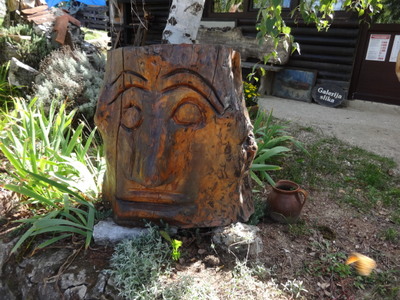
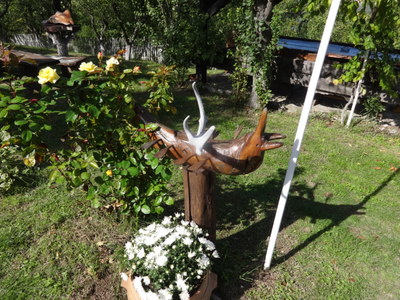 In the one at the left here, he saw faces.
In the one at the left here, he saw faces.
In the one at the right, he spotted one of those strange mermaids sprouting antlers that hang from the ceilings in castles around here. He added the antlers.
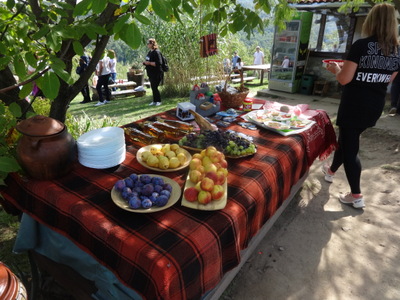
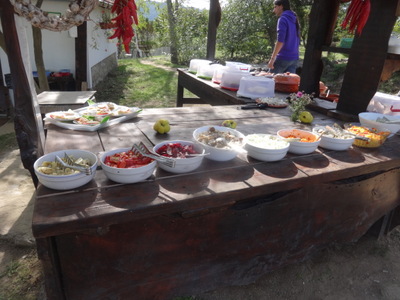 But in addition to the museum, the place functions as an open-air restaurant. Apparently, you have to call ahead, so they know how much food to set out. Here's the fruit buffet, shaded by a Carpathian walnut tree.
But in addition to the museum, the place functions as an open-air restaurant. Apparently, you have to call ahead, so they know how much food to set out. Here's the fruit buffet, shaded by a Carpathian walnut tree.
Nearby was this assortment of marinated vegetable salads.
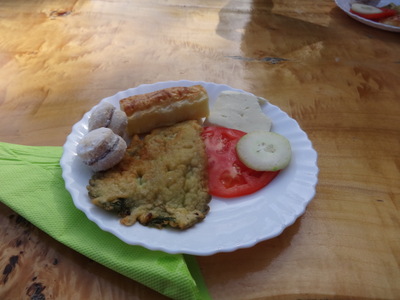
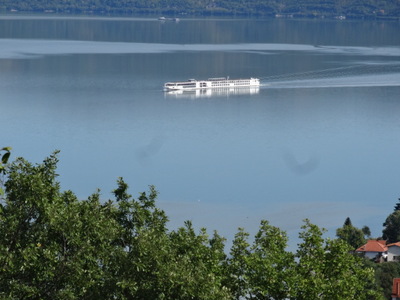 But we were served a set tasting plate—clockwise from 9 o'clock: shortbread cookies sandwiched with jam, a cylindrical phyllo pastry filled with cheese, a slice of another cheese, a cucumber slice, a tomato slice, and the pièce de résistance, a breaded and fried nettle leaf. It was my first chance to eat nettle, but I found that the thick breading completely overpowered the taste of the leaf, and it was all soggy. Maybe that's the point, since apparently Serbian mothers work hard at getting their children to eat nettles, which are rich in iron.
But we were served a set tasting plate—clockwise from 9 o'clock: shortbread cookies sandwiched with jam, a cylindrical phyllo pastry filled with cheese, a slice of another cheese, a cucumber slice, a tomato slice, and the pièce de résistance, a breaded and fried nettle leaf. It was my first chance to eat nettle, but I found that the thick breading completely overpowered the taste of the leaf, and it was all soggy. Maybe that's the point, since apparently Serbian mothers work hard at getting their children to eat nettles, which are rich in iron.
At the right is a (telephotoed) shot of the Vidar passing on the Danube below, on its way to pick us up later in Golubac. The passengers who didn't come on our excursion were, at that point, having Serbian teatime and a demonstration of making poppy-seed strudel.
After the food tasting, we were offered honey brandy—not made from honey but flavored with it. As usual, I found it not bad. That's the secret to making an alcoholic beverage appeal to me; sweeten it heavily.
On our way back to the buses, I paused to look at a movie poster displayed near the exit. The guide stopped to explain to me that it was for a Serbian movie entitled Valter (Walter) about a heroic Serbian soldier. It became very popular in China; now the name is borrowed for all sorts of brand names in Asia.

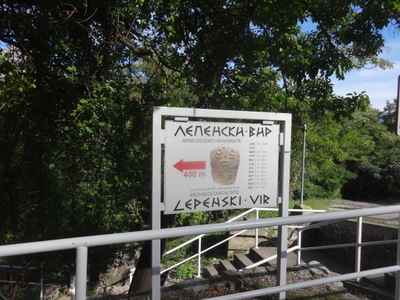 Back in the buses, we continued toward Lepinski Vir. Once the bus parked, we walked through a small open-air museum of relocated buildings, as well as a fruit orchard with apple, pear, quince, and plum trees. A few stalls were selling honey or wine. Over one of them was this astonishing tree. Someone asked the stall-holder, who had apparently been asked a million times before, as she had the English name down pat—it's a "nettle tree" (Celtis sp.).
Back in the buses, we continued toward Lepinski Vir. Once the bus parked, we walked through a small open-air museum of relocated buildings, as well as a fruit orchard with apple, pear, quince, and plum trees. A few stalls were selling honey or wine. Over one of them was this astonishing tree. Someone asked the stall-holder, who had apparently been asked a million times before, as she had the English name down pat—it's a "nettle tree" (Celtis sp.).
Here's the sign pointing down the forest path to Lepenski Vir proper. It was maybe a 10-minute walk through beautiful woods. I didn't catch what he said Lepenski means, but "Vir" he said meant "ripple," or maybe whirlpool.
The site we visited is not that of the actual archeological dig. That was a mile or two away and farther down the mountain side. It was the largest, most important, and probably oldest of a group of 16 settlements spread along the Danube that formed the mesolithic to neolithic Lepenski Vir culture. It was directly across the river from a huge, iron-rich, trapezoidal rock outcrop. Lightning struck the outcrop very often, and the people came to believe it protected them, so they worshiped it as a god.
Unfortunately, when plans were announced for building the giant Iron Gate dam, the archeologists realized the site would be drowned. They asked for time to complete their investigations and were given "until the dam is finished and the water comes up." On the good side, part of their work was recorded in a documentary film, which we saw at the visitors' center. They clearly wouldn't have time, so they dug like crazy at Lepenski Vir and reconstructed the whole site higher up the hill, above the water line. That took all the available time, so the other 15 settlements were drowned after only cursory examination.
The culture of these settlements flourished from mesolithic (2000 years after the ice age) to neolithic times, 4000 years in all. Then it vanished. Its DNA (sequenced from the bones found at Lepenski Vir) later turned up farther west, in central Europe. They are thought to have simply decided to leave and moved away en masse. The guide mentioned that human life began here after the land, which had been the floor of a shallow sea uplifted and tipped all the water into the Black Sea basin.

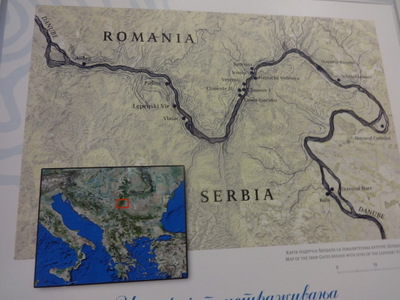 The relocated portions of the dig that we visited are sheltered by a huge green-house-like structure. The red patches you see are the floors of houses, made of baked red clay. Each has a hearth in the center, they all face the same way (toward the giant rock outcrop), and they are all trapezoidal.
The relocated portions of the dig that we visited are sheltered by a huge green-house-like structure. The red patches you see are the floors of houses, made of baked red clay. Each has a hearth in the center, they all face the same way (toward the giant rock outcrop), and they are all trapezoidal.
The photo at the right is a map of the region showing all the settlements of the culture, spread along the river. Lepenski Vir proper is in slightly larger type, directly below the middle "A" of "ROMANIA."
In all, 333 skeletons were found at the site. Early ones were buried supine, the latest ones in fetal position. Just one, 65 years old (really old for the time) was buried in a cross-legged sitting position. Cemeteries were on the fringes of communities; only older people and babies were buried under the houses, and those were always second burials.
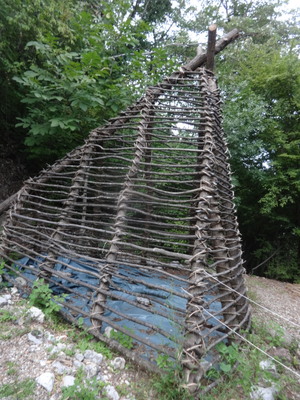
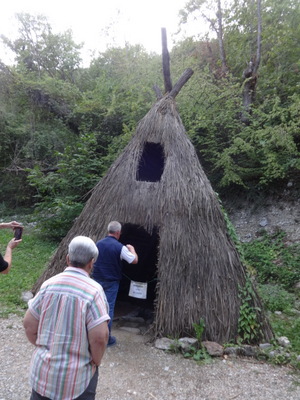 These two photos show what the above-ground portions of the houses are thought to have looked like—log and stick frames covered with thatch and/or mud.
These two photos show what the above-ground portions of the houses are thought to have looked like—log and stick frames covered with thatch and/or mud.
The people were remarkably large and healthy for the time. One individual was 2 m tall! From the 333 skeletons, only 2 teeth are missing, and all 333 died of natural causes. They also lived to a great age for the time. Their diet of sturgeon and caviar contributed a lot of omega oils.
Something (I didn't catch what; genetics maybe) shows that they imported women into the culture from elsewhere but never another man. The imported women taught them agriculture—the beginning of the Neolithic—and they made the transition to it in just two years.
In Mesolithic times, they made clay figurines like the one on the sign above, with eyes and always a fish-mouth shaped mouth. That disappeared entirely in the Neolithic—they made pottery instead. When their diet was 80% fish, they had very thick, strong bones. Once they switched over the agriculture, the bones got thinner.
In the course of the 4000 years of the culture, therefore, many features of their lives changed completely, but never the shape of their houses.
Next after Lepenski Vir was our visit to Golubac Fortress. Things the guide told us on the way:
- Greetings in Serbian are multisyllable affairs, and we on the bus didn't do very well learning them when our guide tried to teach us. He assured us that "ciao" is becoming popular with young people, used alone as "hello" and prefaced with some other syllable to mean "goodby." "Zhivili" is the equivalent of "cheers," when a toast is made.
- The Iron Gate gorge is (was?) the deepest gorge in Europe. Much of it is now flooded, since the construction of the Iron Gate bridge.
- Both of today's destinations are in Djerdap National Park, Serbia's largest. There are no wind turbines on the Serbian side of the river; all are on Romanian side, because more than 270 species of birds inhabit the national park, so no windmills are not allowed.
- Construction of the dam, the largest on the Danube, completely changed everyone's life here. Many towns and villages were flooded out. In particular, one of them has been moved four times. The Ottoman empire arrived in the 17th century and destroyed it. The residents moved to a different spot, which proved too susceptible to flooding. In the 19th century, Prince Milish (spelling?) helped finance the project of moving the village to the other bank. Everyone agreed the result was very comfortable and beautiful, and no longer subject to flooding, so the grateful villagers changed its name to Milanovich. There were 6000 people in the town whemn, in the 1960's they built the dam and flooded it out completely. The communists offered the residents a choice, either a subsidy to move away or a house a quarter the size on a quarter of the land in a rebuilt town; 80% took the opportunity to stay. Now the lake can be used to keep the water level normal, in times of heavy rains, managers have have to lower the water level to make room for the runoff. Sometimes it drops so low that the the old town is exposed, and old people take their grandchildren to see what it was like.
- Another effect of the dam was that it wiped out the sturgeon fishery. No provision was made for fish migrations, so sturgeon no longer exist upstream of the dam. The fishery was a major one. Sturgeon grew so large that a fisherman could make his whole season's income from just one fish (meat and caviar). The record fish was 250 kg (I think he said the world record was 350 kg), and the average was about 100 kg. No legal limit was ever established, but the fishermen agreed among themselves that each should catch only one sturgeon per year; after that they had to fish only for other species. The biggest fish upstream of the dam now is the catfish—the record's 116 kg—and 200 fisher families are down to about 15. The guides grandmother says they survived the war by eating caviar. Other food was hard to come by, and they couldn't sell their catch, so they ate it.
- The big expanse of water formed behind the dam warms the gorge, so even bananas and figs grow here now.
- Serbia was part of Jugoslavia in 1978, and Jugoslavia had just one president, Marshall Josip Broz "Tito." His real name was Josip Broz, but he was famous for going around pointing to people and assigning tasks: "You, do that; you, do that; you, do that." And in Serbian, that sounds like, "Tito, tito, tito," so he got the permanent nickname. He formed Jugoslavia, which means "south-Slavia," to unite all the branches of the south Slavs who migrated south to form the various Slavic nations of the area.
- Unfortunately, Tito didn't name a successor; he wanted the heads of the six countries he had united to form Jugoslavia to rotate in the role. When he died in 1990, that quickly ldevolved into civil war, resulting in six independent republics that have been at each other's throats ever since.
Throughout the cruise, many guides of many different nationalities have tried to list and explain the horrendously complicated series of events—alliances, betrayals, invasions, torture, destruction—and people—warlords, dictators, communists, fascists—that have shaped events in the Balkans in recent history, and nobody comes off looking very good (though some come off better than others). Tito, for example, was pretty benevolent for a dictator, and his legendary negotiation skills were essential to maintaining world peace for a long time, but he was still a dictator, and horrible fates befell anyone who crossed him or otherwise drew his displeasure.
And more than one guide mentioned having carried four different passports in his life, without ever moving out of the house where he grew up, because every invasion, alliance, or other shift in power changed his nationality, and everything had to be reissued.
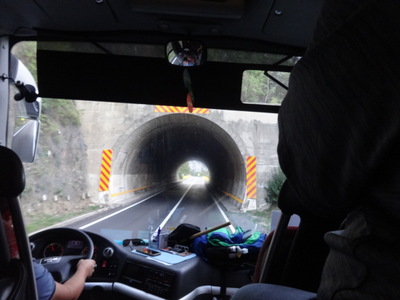
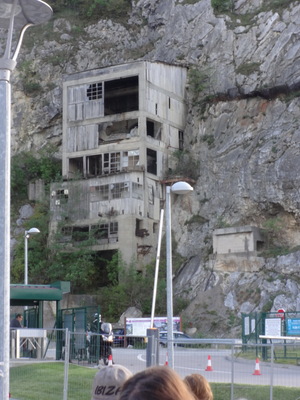 The bus took us back down the mountain from Lepinski Vir, then along the river/lake to our next destination, Golubac Fortress, the most beautiful fortress in Serbia. Along the way, we passed through many short tunnels like the one shown here, until we emerged from the last one to find, quite suddenly, this abandoned structure (the offices of a now-drowned quarry for limestone, used for road building) on our right, and the fortress itself on our left.
The bus took us back down the mountain from Lepinski Vir, then along the river/lake to our next destination, Golubac Fortress, the most beautiful fortress in Serbia. Along the way, we passed through many short tunnels like the one shown here, until we emerged from the last one to find, quite suddenly, this abandoned structure (the offices of a now-drowned quarry for limestone, used for road building) on our right, and the fortress itself on our left.
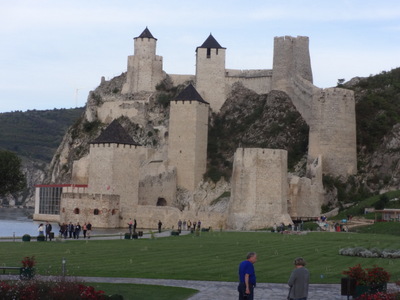
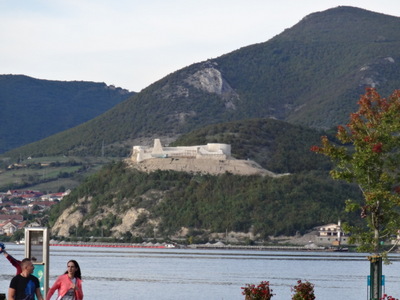 Nobody knows when Golubac was built or by whom. It's been abandoned since the 14th century, so no one knows how it was supposed to look. It consists of 10 separate and independently defensible towers. The newest, built in the 15th and 16th centuries, was closet to the river and is therefore now half under water. Most of the towers started out square, but were modified several times after gunpowder came on the scene and changed the face of war completely. The fortress has been conquered only once in history.
Nobody knows when Golubac was built or by whom. It's been abandoned since the 14th century, so no one knows how it was supposed to look. It consists of 10 separate and independently defensible towers. The newest, built in the 15th and 16th centuries, was closet to the river and is therefore now half under water. Most of the towers started out square, but were modified several times after gunpowder came on the scene and changed the face of war completely. The fortress has been conquered only once in history.
The structure in the photo on the right is across the river/lake in Romania. Our guide told us what it is, but I've forgotten.
Both a Roman house and and Ottoman house are being excavated and reconstructed on the Golubac site, so the place has been occupied at least since Roman times. The excavations reveal evidence of Roman baths, so there must have been warm springs nearby, but no one has been able to locate them.
The guide pointed out to us a huge rock pinnacle across the river from Golubac, only the tip of which is now visible above the water line. Back in the day, a huge chain was strung across the river from the fortress to that rock, effectively blocking all shipping, so the fortress could control all traffic on the river—both for defensive and for commercial purposes.
The place takes it name from Golubana, a beautiful maiden who refused to marry the powerful man who wanted her. He marooned her on the rock pinnacle until she agreed to the marriage. Local fishermen brought her food and water, and she supposedly grew old and died there rather than submit.
The guide also pointed out a small island in the lake, which was a much larger island in the river before the dam was built. Romania smelted copper on the far bank, and disposal of the toxic slag was a problem. They therefore starting building a bridge to the island, planning to dump it all over there. Fortunately, Jugoslavia refused to allow them to complete the bridge, which still stands in its half-finished state. Of course, when the gorge was flooded and half the island drowned, that slag heap would have been an environmental and public-health disaster.
In earlier times that island was an important trading post because ships needed the residents to help haul them past a shallow spot in the river, so the islanders could charge tolls without having to string a chain across the stream.
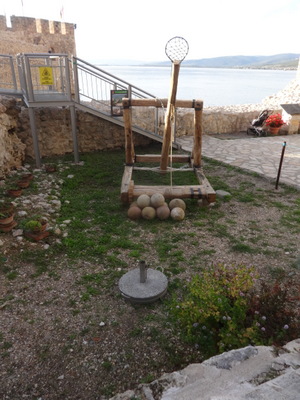
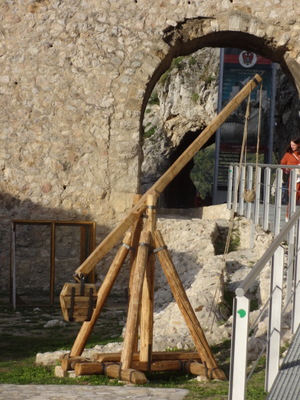 But back to Golubac. Here, left and right, are two full-size and apparently functional catapults displayed among the towers. One works on energy-stored-in-a-twisted-spring principal and the other by means of a counterweight.
But back to Golubac. Here, left and right, are two full-size and apparently functional catapults displayed among the towers. One works on energy-stored-in-a-twisted-spring principal and the other by means of a counterweight.
The most hair-raising thing we learned about the site is that, when the road was built in the 1920s, the engineers who constructed all those tunnels built one right through the castle! It was just another piece of the mountain to them, and it was in the way. Now, of course, the country is spending 10 million euros restoring it. The tunnel we drove through goes around the fortress, through the mountain proper, and the damage to the fortress is being reversed.
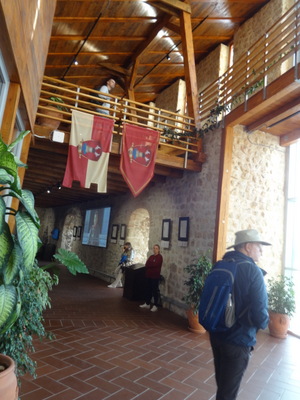
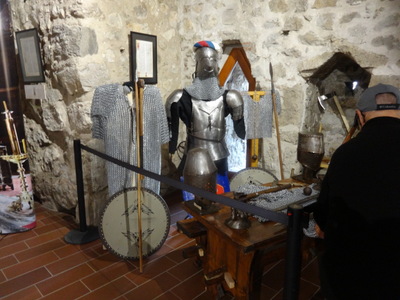 On the river side of the fortress, they've built on a beautiful modern visitors' center. You might think that's David in the left-hand photo, but no—it's another visitor who also happens to wear a white canvas Tilley hat.
On the river side of the fortress, they've built on a beautiful modern visitors' center. You might think that's David in the left-hand photo, but no—it's another visitor who also happens to wear a white canvas Tilley hat.
In the right-hand photo is a hands-on display that allows visitors to lift a piece of chain mail, which, as the display is intended to reveal, is really heavy. I'm amazed those guys would stand up in it, let alone fight (or find horses that could carry them)!
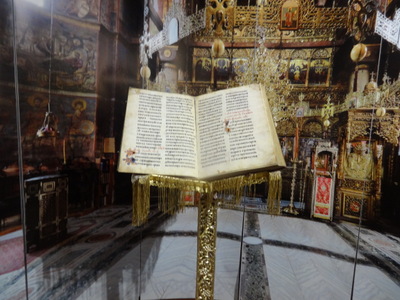
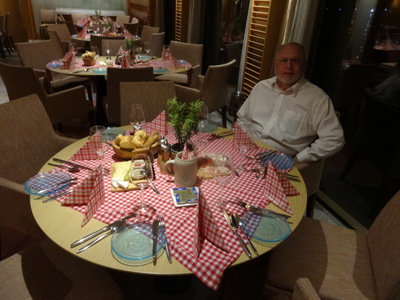 Also displayed in the visitors' center is this replica of the oldest book in Serbia, from the 12th century. We were allowed to walk right up and turn the pages. Needless to say, the original is someplace much safer and better climate controlled.
Also displayed in the visitors' center is this replica of the oldest book in Serbia, from the 12th century. We were allowed to walk right up and turn the pages. Needless to say, the original is someplace much safer and better climate controlled.
After visiting the fortress, we strolled across the courtyard to the Vidar, which had arrived there just about the time our bus did, passing those passengers who had elected not to go to Lepenski Vir but just to stay on the ship as it sailed here to Golubac, now on their way to explore the fortress. We were also rejoined by those who had disembarked with us after lunch to go on the Djerdap National Park hike.
Everybody was warned to be back on board by 7:15 pm, and at 7:30 pm, as we sat down to our special "Taste of the Balkans" dinner (on red-checked tablecloths, as shown in the righthand photo), the ship sailed, bound for Belgrade.
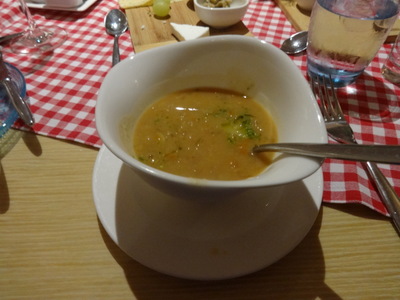
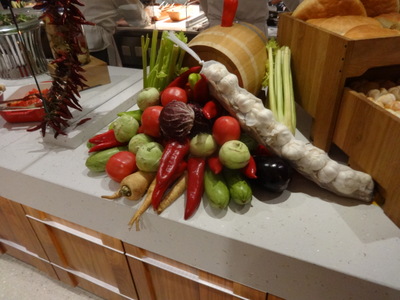 The menu for the dinner read, in its entirety, "traditional Serbian white bean soup; roast pork; roast chicken; grilled garlic lamb; potato wedges; rice pilaf; herb yogurt." I actually added the semicolon after "soup," which was missing in the original.
The menu for the dinner read, in its entirety, "traditional Serbian white bean soup; roast pork; roast chicken; grilled garlic lamb; potato wedges; rice pilaf; herb yogurt." I actually added the semicolon after "soup," which was missing in the original.
At the left is the soup, which like all the soups on this trip, on and off the ship, was excellent.
The right-hand photo shows the decorative display of produce. I never saw kohlrabi mentioned on a menu, but it may have been in there somewhere.
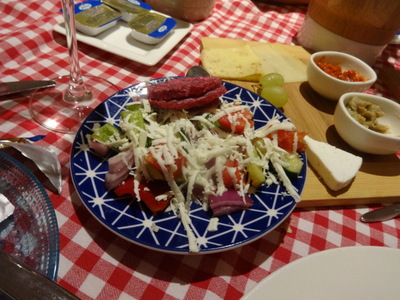
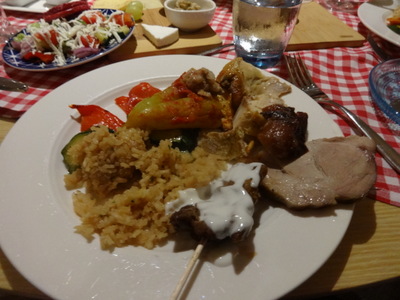 We were each served this salad, which sort of approximates that prize-winning Bulgarian one, but with the addition of a couple of particularly delicious crinkle-cut slices of marinated beet.
We were each served this salad, which sort of approximates that prize-winning Bulgarian one, but with the addition of a couple of particularly delicious crinkle-cut slices of marinated beet.
At the right is my plate of all the stuff listed on the menu. Looking and thinking back, I don't see where the potatoes came into it, but as you can see, I did not go hungry without them. To the right of the salad in this photo, you can see the appetizers we were served even before the soup—eggplant and tomato dips, grapes, and little wedges of mild white cheese.
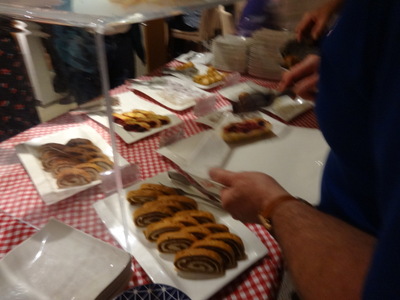
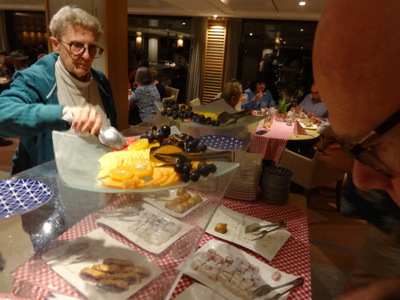 Then came the dessert buffet—a whole assortment of strudels, babkas, baklavas, and Turkish delight.
Then came the dessert buffet—a whole assortment of strudels, babkas, baklavas, and Turkish delight.
In the right-hand photo, fellow passenger Marliss selects from the fruit platter above the pastries. The dining room used those tall plexiglas boxes all the time to fit more stuff on the buffet tables.
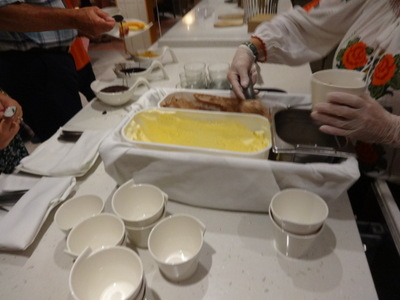 And in case nothing there appealed to you, here's the ice-cream service, scooped by a Balkan-costumed waitress and accompanied by assorted ad-lib self-serve sauces.
And in case nothing there appealed to you, here's the ice-cream service, scooped by a Balkan-costumed waitress and accompanied by assorted ad-lib self-serve sauces.
After dinner, in the lounge, our flamboyant Program Director, Marek, told all comers about the real story of the real historic Count Dracula. He used slides, including time lines, photos, images of paintings, etc., but as he had explained earlier, when he just lectured on the topic, he could see people's eyes glaze over in minutes, so instead, he dressed up and conducted the whole thing as Dracula himself, thickening his Slovakian accent, and hamming it up. I didn't go—I had photos and notes to download—but I watched on the lounge cam!
Previous entry
List of Entries
Next entry

 We set our clocks back an hour last night, so now (and for the rest of the trip) we're on ordinary western European time (1 hour later than Greenwich). At our entrance into the former Jugoslavia, we were greated by this huge monument to Tito, it first and only ruler, and shortly thereafter we approached and passed through the famous "Iron Gate" on the Danube. The Danube has been dammed at this point, so we had to climb over the dams—we passed through the lock at the first dam during the night, but about 6:30 am, I got to watch our passage through the second, which was a double. The first chamber opened directly into the second. This lock's doors open like scissors; the top have goes up and the bottom half goes down. We seemed to be the only vessel in this lock.
We set our clocks back an hour last night, so now (and for the rest of the trip) we're on ordinary western European time (1 hour later than Greenwich). At our entrance into the former Jugoslavia, we were greated by this huge monument to Tito, it first and only ruler, and shortly thereafter we approached and passed through the famous "Iron Gate" on the Danube. The Danube has been dammed at this point, so we had to climb over the dams—we passed through the lock at the first dam during the night, but about 6:30 am, I got to watch our passage through the second, which was a double. The first chamber opened directly into the second. This lock's doors open like scissors; the top have goes up and the bottom half goes down. We seemed to be the only vessel in this lock. 
 Hors d'oeuvres were passed at 11 am in the lounge. I got a lttle ball of falafel on hummus. At the right is a photo of the water bottle in my stateroom. Viking keeps us well supplied with water. You find one of these quart glass bottles, with synthetic cork and shrink-wrap seal, in your room when you arrive, and they replace them as fast as you can use them up. If you leave one half full, they add a new one.
Hors d'oeuvres were passed at 11 am in the lounge. I got a lttle ball of falafel on hummus. At the right is a photo of the water bottle in my stateroom. Viking keeps us well supplied with water. You find one of these quart glass bottles, with synthetic cork and shrink-wrap seal, in your room when you arrive, and they replace them as fast as you can use them up. If you leave one half full, they add a new one. 
 The fine-print starter was a little dish of potato salad with bacon.
The fine-print starter was a little dish of potato salad with bacon.
 David started with the "Italian salad." The red slices are bresaola, air-dried beef.
David started with the "Italian salad." The red slices are bresaola, air-dried beef. 
 David's main course was pasta Alfredo. Then I think we both had the banana cake—a layer of banana slices sandwiched between two layers of cake and topped with a little chocolate.
David's main course was pasta Alfredo. Then I think we both had the banana cake—a layer of banana slices sandwiched between two layers of cake and topped with a little chocolate.

 This antique (a fire engine? farm equipment?) was on display where the ship moored briefly after lunch (Donji Milanovac, billed as is the smallest town in eastern Serbia; only 2000 people) to let us off for our afternoon excursion. We had to take our passports with us, because foreigners are required to carry them everywhere they go in Serbia, so we checked them out from the Viking vault for the duration of our time in the country.
This antique (a fire engine? farm equipment?) was on display where the ship moored briefly after lunch (Donji Milanovac, billed as is the smallest town in eastern Serbia; only 2000 people) to let us off for our afternoon excursion. We had to take our passports with us, because foreigners are required to carry them everywhere they go in Serbia, so we checked them out from the Viking vault for the duration of our time in the country. 
 We were signed up for the 1:30 pm trip to the archeological site of Lepenski Vir, but after 10 or 12 minutes on the bus, we stopped at the Kapetan Mišin Breg Open Air Gallery for a snack and sight-seeing. That's its front gate in the right-hand photo. Kapetan Mišin is apparently something of a local hero. He made his money in trade and became a philanthropist. He left two of his houses to the local people—one became a university and the other the National Bank of Romania.
We were signed up for the 1:30 pm trip to the archeological site of Lepenski Vir, but after 10 or 12 minutes on the bus, we stopped at the Kapetan Mišin Breg Open Air Gallery for a snack and sight-seeing. That's its front gate in the right-hand photo. Kapetan Mišin is apparently something of a local hero. He made his money in trade and became a philanthropist. He left two of his houses to the local people—one became a university and the other the National Bank of Romania.
 His avocation is to search the woods for pieces of wood in which he sees shapes. He then further shapes them to bring out what he sees, varnishes them, and displays them throughout the grounds, which include fruit orchards, paths, flower beds, and lawns, as the "Wood and Water" gallery. They are not for sale.
His avocation is to search the woods for pieces of wood in which he sees shapes. He then further shapes them to bring out what he sees, varnishes them, and displays them throughout the grounds, which include fruit orchards, paths, flower beds, and lawns, as the "Wood and Water" gallery. They are not for sale.
 In the one at the left here, he saw faces.
In the one at the left here, he saw faces.
 But in addition to the museum, the place functions as an open-air restaurant. Apparently, you have to call ahead, so they know how much food to set out. Here's the fruit buffet, shaded by a Carpathian walnut tree.
But in addition to the museum, the place functions as an open-air restaurant. Apparently, you have to call ahead, so they know how much food to set out. Here's the fruit buffet, shaded by a Carpathian walnut tree.
 But we were served a set tasting plate—clockwise from 9 o'clock: shortbread cookies sandwiched with jam, a cylindrical phyllo pastry filled with cheese, a slice of another cheese, a cucumber slice, a tomato slice, and the pièce de résistance, a breaded and fried nettle leaf. It was my first chance to eat nettle, but I found that the thick breading completely overpowered the taste of the leaf, and it was all soggy. Maybe that's the point, since apparently Serbian mothers work hard at getting their children to eat nettles, which are rich in iron.
But we were served a set tasting plate—clockwise from 9 o'clock: shortbread cookies sandwiched with jam, a cylindrical phyllo pastry filled with cheese, a slice of another cheese, a cucumber slice, a tomato slice, and the pièce de résistance, a breaded and fried nettle leaf. It was my first chance to eat nettle, but I found that the thick breading completely overpowered the taste of the leaf, and it was all soggy. Maybe that's the point, since apparently Serbian mothers work hard at getting their children to eat nettles, which are rich in iron.
 Back in the buses, we continued toward Lepinski Vir. Once the bus parked, we walked through a small open-air museum of relocated buildings, as well as a fruit orchard with apple, pear, quince, and plum trees. A few stalls were selling honey or wine. Over one of them was this astonishing tree. Someone asked the stall-holder, who had apparently been asked a million times before, as she had the English name down pat—it's a "nettle tree" (Celtis sp.).
Back in the buses, we continued toward Lepinski Vir. Once the bus parked, we walked through a small open-air museum of relocated buildings, as well as a fruit orchard with apple, pear, quince, and plum trees. A few stalls were selling honey or wine. Over one of them was this astonishing tree. Someone asked the stall-holder, who had apparently been asked a million times before, as she had the English name down pat—it's a "nettle tree" (Celtis sp.).
 The relocated portions of the dig that we visited are sheltered by a huge green-house-like structure. The red patches you see are the floors of houses, made of baked red clay. Each has a hearth in the center, they all face the same way (toward the giant rock outcrop), and they are all trapezoidal.
The relocated portions of the dig that we visited are sheltered by a huge green-house-like structure. The red patches you see are the floors of houses, made of baked red clay. Each has a hearth in the center, they all face the same way (toward the giant rock outcrop), and they are all trapezoidal.
 These two photos show what the above-ground portions of the houses are thought to have looked like—log and stick frames covered with thatch and/or mud.
These two photos show what the above-ground portions of the houses are thought to have looked like—log and stick frames covered with thatch and/or mud.
 The bus took us back down the mountain from Lepinski Vir, then along the river/lake to our next destination, Golubac Fortress, the most beautiful fortress in Serbia. Along the way, we passed through many short tunnels like the one shown here, until we emerged from the last one to find, quite suddenly, this abandoned structure (the offices of a now-drowned quarry for limestone, used for road building) on our right, and the fortress itself on our left.
The bus took us back down the mountain from Lepinski Vir, then along the river/lake to our next destination, Golubac Fortress, the most beautiful fortress in Serbia. Along the way, we passed through many short tunnels like the one shown here, until we emerged from the last one to find, quite suddenly, this abandoned structure (the offices of a now-drowned quarry for limestone, used for road building) on our right, and the fortress itself on our left. 
 Nobody knows when Golubac was built or by whom. It's been abandoned since the 14th century, so no one knows how it was supposed to look. It consists of 10 separate and independently defensible towers. The newest, built in the 15th and 16th centuries, was closet to the river and is therefore now half under water. Most of the towers started out square, but were modified several times after gunpowder came on the scene and changed the face of war completely. The fortress has been conquered only once in history.
Nobody knows when Golubac was built or by whom. It's been abandoned since the 14th century, so no one knows how it was supposed to look. It consists of 10 separate and independently defensible towers. The newest, built in the 15th and 16th centuries, was closet to the river and is therefore now half under water. Most of the towers started out square, but were modified several times after gunpowder came on the scene and changed the face of war completely. The fortress has been conquered only once in history.

 But back to Golubac. Here, left and right, are two full-size and apparently functional catapults displayed among the towers. One works on energy-stored-in-a-twisted-spring principal and the other by means of a counterweight.
But back to Golubac. Here, left and right, are two full-size and apparently functional catapults displayed among the towers. One works on energy-stored-in-a-twisted-spring principal and the other by means of a counterweight.
 On the river side of the fortress, they've built on a beautiful modern visitors' center. You might think that's David in the left-hand photo, but no—it's another visitor who also happens to wear a white canvas Tilley hat.
On the river side of the fortress, they've built on a beautiful modern visitors' center. You might think that's David in the left-hand photo, but no—it's another visitor who also happens to wear a white canvas Tilley hat.
 Also displayed in the visitors' center is this replica of the oldest book in Serbia, from the 12th century. We were allowed to walk right up and turn the pages. Needless to say, the original is someplace much safer and better climate controlled.
Also displayed in the visitors' center is this replica of the oldest book in Serbia, from the 12th century. We were allowed to walk right up and turn the pages. Needless to say, the original is someplace much safer and better climate controlled.
 The menu for the dinner read, in its entirety, "traditional Serbian white bean soup; roast pork; roast chicken; grilled garlic lamb; potato wedges; rice pilaf; herb yogurt." I actually added the semicolon after "soup," which was missing in the original.
The menu for the dinner read, in its entirety, "traditional Serbian white bean soup; roast pork; roast chicken; grilled garlic lamb; potato wedges; rice pilaf; herb yogurt." I actually added the semicolon after "soup," which was missing in the original.
 We were each served this salad, which sort of approximates that prize-winning Bulgarian one, but with the addition of a couple of particularly delicious crinkle-cut slices of marinated beet.
We were each served this salad, which sort of approximates that prize-winning Bulgarian one, but with the addition of a couple of particularly delicious crinkle-cut slices of marinated beet.
 Then came the dessert buffet—a whole assortment of strudels, babkas, baklavas, and Turkish delight.
Then came the dessert buffet—a whole assortment of strudels, babkas, baklavas, and Turkish delight. And in case nothing there appealed to you, here's the ice-cream service, scooped by a Balkan-costumed waitress and accompanied by assorted ad-lib self-serve sauces.
And in case nothing there appealed to you, here's the ice-cream service, scooped by a Balkan-costumed waitress and accompanied by assorted ad-lib self-serve sauces.